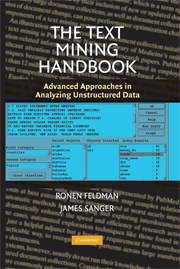Book contents
- Frontmatter
- Contents
- Preface
- I Introduction to Text Mining
- II Core Text Mining Operations
- III Text Mining Preprocessing Techniques
- IV Categorization
- V Clustering
- VI Information Extraction
- VII Probabilistic Models for Information Extraction
- VIII Preprocessing Applications Using Probabilistic and Hybrid Approaches
- IX Presentation-Layer Considerations for Browsing and Query Refinement
- X Visualization Approaches
- XI Link Analysis
- XII Text Mining Applications
- Appendix A DIAL: A Dedicated Information Extraction Language for Text Mining
- Bibliography
- Index
Appendix A - DIAL: A Dedicated Information Extraction Language for Text Mining
Published online by Cambridge University Press: 08 August 2009
- Frontmatter
- Contents
- Preface
- I Introduction to Text Mining
- II Core Text Mining Operations
- III Text Mining Preprocessing Techniques
- IV Categorization
- V Clustering
- VI Information Extraction
- VII Probabilistic Models for Information Extraction
- VIII Preprocessing Applications Using Probabilistic and Hybrid Approaches
- IX Presentation-Layer Considerations for Browsing and Query Refinement
- X Visualization Approaches
- XI Link Analysis
- XII Text Mining Applications
- Appendix A DIAL: A Dedicated Information Extraction Language for Text Mining
- Bibliography
- Index
Summary
WHAT IS THE DIAL LANGUAGE?
This appendix provides an example of a dedicated information extraction language called DIAL (declarative information analysis language). The purpose of the appendix is to show the general structure of the language and offer some code examples that will demonstrate how it can be used to extract concepts and relationships; hence, we will not cover all aspects and details of the language.
The DIAL language is a dedicated information extraction language enabling the user to define concepts whose instances are found in a text body by the DIAL engine. A DIAL concept is a logical entity, which can represent a noun (such as a person, place, or institution), an event (such as a business merger between two companies or the election of a president), or any other entity for which a text pattern can be defined. Instances of concepts are found when the DIAL engine succeeds in matching a concept pattern to part of the text it is processing. Concepts may have attributes, which are properties belonging to the concept whose values are found in the text of the concept instance. For instance, a “Date” concept might have numeric day, month, and year attributes and a string attribute for the day of the week.
A DIAL concept declaration defines the concept's name, attributes, and optionally some additional code common to all instances of the concept.
- Type
- Chapter
- Information
- The Text Mining HandbookAdvanced Approaches in Analyzing Unstructured Data, pp. 315 - 334Publisher: Cambridge University PressPrint publication year: 2006



